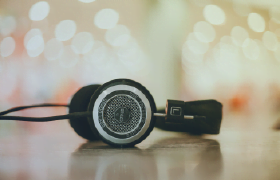5 tips on recording audio for eLearning courses
Good audio is critical to your eLearning courses. Whether it’s an echo, or background noise, poor audio can distract your learners from the content in your eLearning course.
There is a perception that creating good quality audio yourself is costly. The truth is, recording high quality audio in house doesn’t require professional tools, special training, or a thousand pound budget. All it takes is a few simple and sometimes free tools and tips. Check out our five top tips for recording your own high quality audio for eLearning:
1. A good microphone
When it comes to microphones, you typically get what you pay for. A cheap microphone will provide the same function but it won’t provide you with good audio quality. When choosing a microphone, it’s best to pick an unidirectional mic. This is great for recording in house audio because it only picks up the sound coming from the narrator, so you won’t get a lot of background noise. A headset microphone is another great choice as you don’t have to worry about positioning the mic as it is fixed to your head, creating a consistent sound.
2. Maintain a consistent environment
The more you control the recording environment, the better audio quality you can record. Even small changes to your environment can result in inconsistencies in the sound of your audio. When recording audio:
- Use the same microphone each time you record. Microphones have personalities and changing mics can change your audio quality.
- Try to use the same recording room and maintain the same settings on your computer.
- Attempt to complete all of the recording in a single session.
3. Background noise
Noticeable background noise is a source of distraction in an audio recording. But, if it’s impossible to find a place that is completely soundproof, you can try these tips below to reduce background noise from your recording:
- Close windows to keep traffic noise out.
- Place your microphone away from your computer. You might not realise it, but your computer makes a lot of fan noise.
- Request everyone around you to keep their voice down while you’re recording.
4. Use the right software
eLearning authoring tools now come with built in recording and editing features. These features are great for quick recording edits; however they normally lack features required to enhance audio quality.
When looking for recording software, look for programs that offer noise reduction/cancellation and audio levelling features. These features can help you improve your audio quality significantly. Some of the software that you can check out are:
- Audacity (Free)
- If you use a Mac, it comes installed with Garage Band which is great for editing audio recordings.
- Adobe Audition
5. Location
When you record, you aren’t just recording your voice. The microphone will also pick up the way that your voice interacts with the environment around you. The room that you record in will have a big impact on the quality of your recording. A room that is too big will make you sound distant and difficult to understand and a room that is too small will have a louder echo. An ideal recording room will have a lot of soft furnishings (for example a living room or bedroom) so that they can act as a buffer and absorb the sound waves. If you are recording audio in an office, books are a great option to help dampen the echo.
There is always more to learn about recording and vocal techniques to achieve great quality audio. But with these tips you are well-equipped to record audio for your next project! Have any of your own? Why not leave them in the comments below.

















 BACK
BACK
